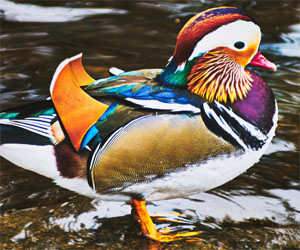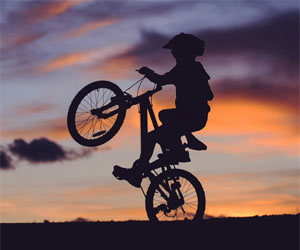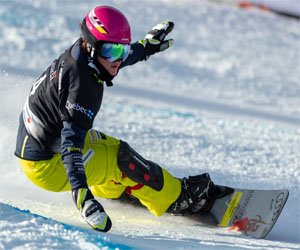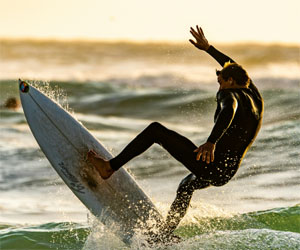


Finding Peace In The World Of Feathers

In today's fast-paced world, the quest for relaxation and stress relief is a universal endeavor. Amid the hustle and bustle of daily life, there's an age-old pastime that offers solace and serenity: birdwatching. This gentle pursuit of observing birds in their natural habitats has a unique power to soothe the mind and rejuvenate the soul. In this article, we will explore how birdwatching can be a remarkable means of relaxation.
Nature's Tranquil Haven: Birdwatching takes you to some of the most serene and tranquil corners of the natural world. Whether you're perched on a park bench or nestled in the woods, the act of focusing on the sights and sounds of birds creates a connection with nature that calms the mind. The rustling leaves, gentle streams, and melodious bird songs provide a harmonious backdrop for relaxation.
Mindful Presence: Birdwatching encourages a state of mindfulness, where you become fully present in the moment. The act of observing birds requires concentration and patience, allowing you to escape the worries of yesterday and the anxieties of tomorrow. Your focus shifts to the intricate beauty of the avian world unfolding before you.
Stress Reduction: Research has shown that spending time in natural settings, like birdwatching in a park or forest, can significantly reduce stress levels. The gentle rhythm of watching birds, paired with the release of stress-reducing hormones, can lead to a sense of calm and inner peace.
Connection With Wildlife: Birds are our neighbors in the natural world, and watching them up close can foster a deep sense of connection with the environment. This connection not only brings joy but also creates an awareness of the delicate balance of nature, motivating us to protect it.
Escape From Screens: In an age dominated by screens and digital distractions, birdwatching offers a welcome break from the constant buzz of technology. It's an opportunity to unplug, recharge, and reconnect with the real world.
Healthy Outdoor Activity: Birdwatching encourages outdoor activity and gentle exercise. Whether you're hiking to spot a rare species or simply strolling through a local park, being in the open air and walking amidst nature can improve physical health while promoting relaxation.
Community And Social Engagement: Birdwatching can also be a social activity. Joining local birdwatching groups or participating in birding events allows you to share your passion with like-minded individuals, providing a sense of community and camaraderie.
Personal Growth: As you delve deeper into birdwatching, you will develop a broader understanding of the avian world. This can be intellectually stimulating and rewarding, offering a sense of personal growth and accomplishment.
Birdwatching is a simple and accessible way to find relaxation in the beauty of the natural world. It's a practice that transcends age, physical ability, and geographical location, making it a universal means of rejuvenation. Whether you're seeking a moment of solitude, a path to mindfulness, or a way to connect with others who share your passion, birdwatching offers an oasis of tranquility in a busy world. So, consider grabbing a pair of binoculars, a field guide, and a quiet spot outdoors, and let the world of feathers bring you the relaxation you seek.
A Thrilling Adventure
 One of the most captivating aspects of conquering trails and terrain on a mountain bike is the ever-changing landscape. Riders can transition from gentle dirt paths to rocky, technical descents, and back again in a matter of minutes. This dynamic experience keeps the adrenaline pumping and the senses heightened, making each ride a unique adventure.
One of the most captivating aspects of conquering trails and terrain on a mountain bike is the ever-changing landscape. Riders can transition from gentle dirt paths to rocky, technical descents, and back again in a matter of minutes. This dynamic experience keeps the adrenaline pumping and the senses heightened, making each ride a unique adventure.
The versatility of mountain biking means that riders can choose trails that match their skill level. Beginners can start with smoother, more straightforward paths, while experienced riders seek out challenging routes with steep inclines, sharp turns, and obstacles to navigate. It's a sport that offers progression, so as riders become more skilled, they can tackle increasingly demanding terrain.
Conquering trails and terrain on a mountain bike is not just about the physical aspect; it's a mental challenge as well. Riders must make quick decisions, read the trail ahead, and adapt to changing conditions. It's a test of focus, determination, and problem-solving skills.
Safety is paramount when exploring these trails, and riders should wear appropriate protective gear, including a helmet, gloves, and body armor. Additionally, it's crucial to maintain the mountain bike in top condition, ensuring the brakes, suspension, and tires are in optimal working order. Many riders also find it helpful to ride with a buddy, enhancing safety and sharing the joy of the adventure.
When it comes to technique, riders should practice proper body positioning, balance, and weight distribution to maintain control on challenging terrain.
Embracing Nature's Hidden Beauty
 The Appeal Of Untouched Landscapes: Untouched landscapes beckon explorers and nature enthusiasts with promises of solitude, serenity, and unparalleled beauty. These are the places where nature's true character reveals itself, unaltered by human intervention. The appeal lies in the raw, unspoiled beauty that stirs the soul and offers a rare opportunity to witness the world as it was meant to be.
The Appeal Of Untouched Landscapes: Untouched landscapes beckon explorers and nature enthusiasts with promises of solitude, serenity, and unparalleled beauty. These are the places where nature's true character reveals itself, unaltered by human intervention. The appeal lies in the raw, unspoiled beauty that stirs the soul and offers a rare opportunity to witness the world as it was meant to be.
Exploration And Adventure: Discovering untouched landscapes often involves exploration and adventure. These areas are typically off the beaten path and may require more effort to reach. Whether it's hiking through dense forests, kayaking down remote rivers, or trekking through rugged terrain, adventurers are rewarded with the thrill of uncovering nature's hidden gems.
Preserving Pristine Environments: For those who undertake the journey of discovering untouched landscapes, there is a sense of responsibility to preserve these pristine environments. With a commitment to Leave No Trace principles, visitors aim to minimize their impact, ensuring that these places remain unspoiled for future generations to enjoy.
Remote Wilderness Areas: Untouched landscapes can be found in remote wilderness areas around the world. These places are often far from civilization and may lack modern amenities, which is precisely what makes them so special. Remote wilderness areas provide an opportunity to disconnect from the modern world and reconnect with the natural world.
Embrace The Snowy Slopes
 The Basics Of Skiing And Snowboarding: Before you hit the slopes, it's essential to understand the fundamental differences between skiing and snowboarding. Skiing involves using two separate skis on your feet, while snowboarding employs a single snowboard. Skiing is typically easier to learn for beginners as it allows for better balance, while snowboarding requires a bit more coordination but offers a unique sense of control and style.
The Basics Of Skiing And Snowboarding: Before you hit the slopes, it's essential to understand the fundamental differences between skiing and snowboarding. Skiing involves using two separate skis on your feet, while snowboarding employs a single snowboard. Skiing is typically easier to learn for beginners as it allows for better balance, while snowboarding requires a bit more coordination but offers a unique sense of control and style.
Choosing The Right Gear: Selecting the right equipment is crucial to your success on the slopes. Make sure to invest in well-fitted boots, skis or a snowboard, and appropriate clothing to keep you warm and dry. Rental equipment is a cost-effective option for beginners, allowing you to test the sport before committing to your own gear.
Lessons And Instruction: Enrolling in lessons with a certified instructor is a wise choice for beginners. Ski schools and snowboarding instructors can provide you with proper guidance, teach you the essential techniques, and ensure your safety. They will help you learn how to balance, turn, and stop effectively, reducing the risk of injuries.
Understanding Terrain: Ski resorts offer various terrains, including green (beginner), blue (intermediate), and black (advanced) slopes. Start on the green slopes to practice your skills and build confidence.






The Key To Longevity In Sports
 2. Proper Technique And Form: Training in the correct technique and form is crucial to preventing injuries. Athletes must learn how to execute movements and actions accurately to reduce the risk of injury.
2. Proper Technique And Form: Training in the correct technique and form is crucial to preventing injuries. Athletes must learn how to execute movements and actions accurately to reduce the risk of injury.
3. Warm-Up And Cool-Down: Effective warm-up routines prepare the body for exercise by increasing blood flow and raising body temperature. Cool-downs help the body recover and prevent muscle soreness. Both are vital components of injury prevention.
4. Nutrition And Hydration: Proper nutrition and hydration support overall health and recovery. Athletes should maintain a balanced diet to provide the necessary fuel for the body and stay well-hydrated to perform at their best.
5. Rest And Recovery: Adequate rest and recovery are critical for preventing overuse injuries. Sleep and relaxation are key to allowing the body to repair and regenerate. Overtraining can lead to fatigue and an increased risk of injury.
6. Mental Resilience: Incorporating mental health and resilience training can help athletes cope with the stress and pressure of competition. A strong mental state can also help athletes make better decisions and reduce the risk of impulsive actions that can lead to injuries.
7. Listen To The Body: Athletes must pay attention to their bodies and listen to the signals they provide. Pain, discomfort, or unusual sensations can be indicators of potential injuries. Ignoring these signals can lead to severe problems.
8. Injury Prevention Workshops: Attending injury prevention workshops and classes can provide athletes with specialized techniques and strategies to reduce injury risks in their chosen sport. These workshops are often facilitated by experts and can offer valuable insights.
Surfboard Designs For Beginners
 Volume: Longboards have ample volume, aiding in buoyancy and making it easier for novice surfers to catch smaller waves.
Volume: Longboards have ample volume, aiding in buoyancy and making it easier for novice surfers to catch smaller waves.
Longboards are perfect for learning the basics of paddling, balancing, and wave-catching. They offer a forgiving platform for new surfers, allowing them to gain confidence and experience the joy of riding waves.
Foam Boards: The Soft Landing
Foam boards, or soft-top surfboards, are another excellent choice for beginners. These boards are constructed with a soft, foam-covered deck, making them exceptionally safe for newcomers. Key features of foam boards include:
Safety: Foam boards reduce the risk of injury during falls, thanks to their soft construction.
Buoyancy: They offer sufficient buoyancy for easy paddling and wave-catching.
Stability: The wide and stable platform helps beginners find their balance.
The forgiving nature of foam boards makes them a popular choice for surf schools and those learning to surf for the first time.